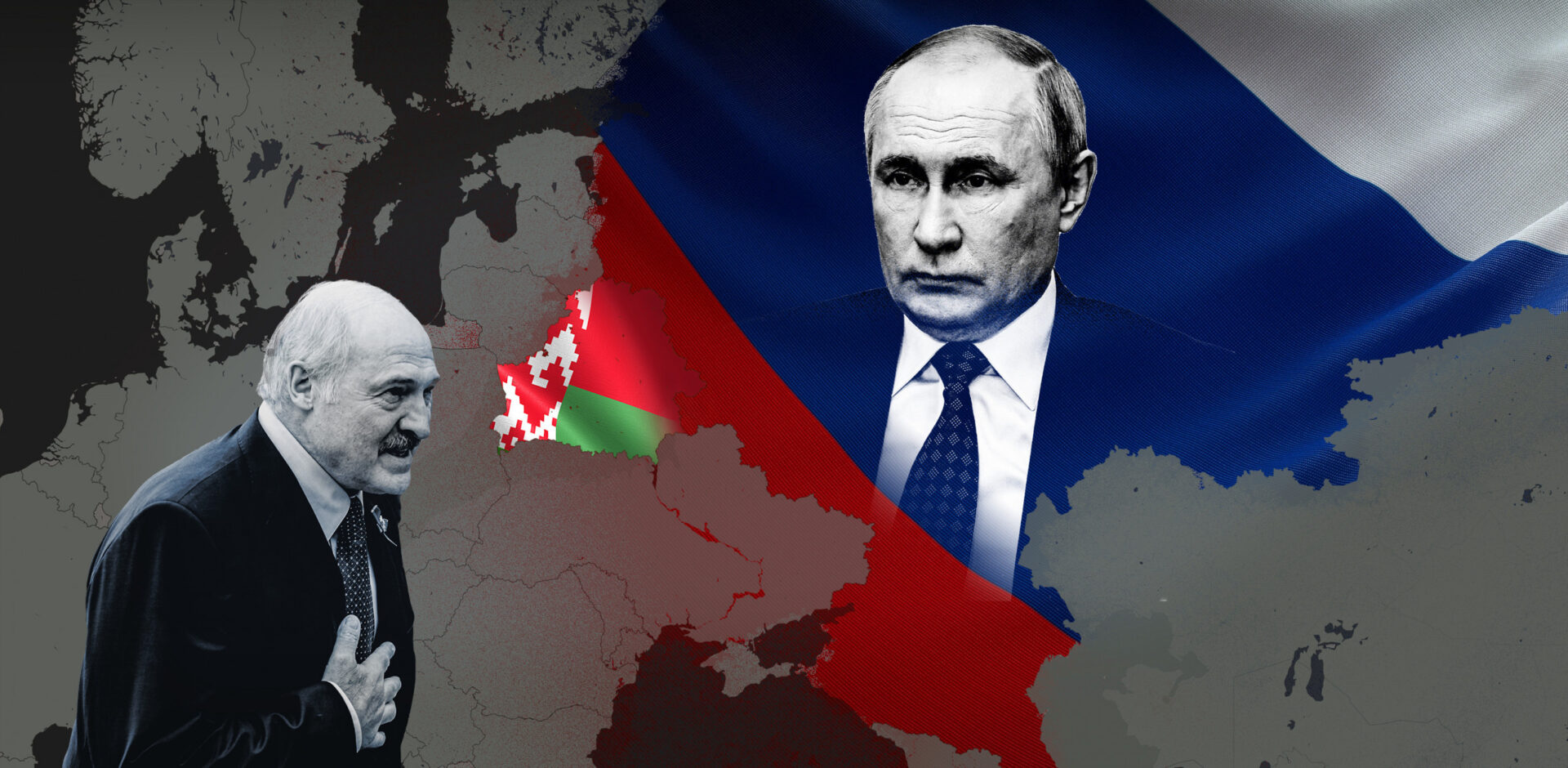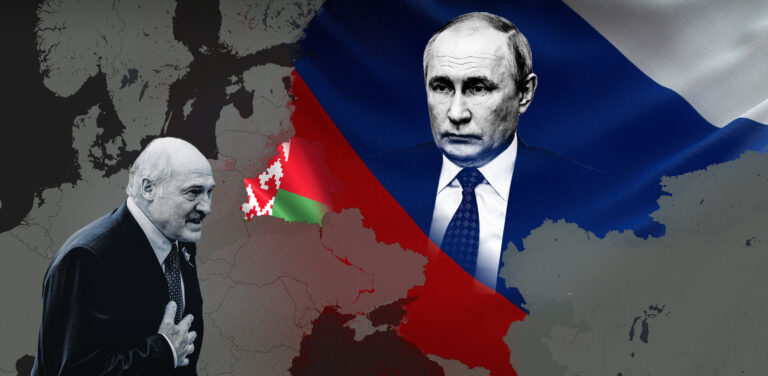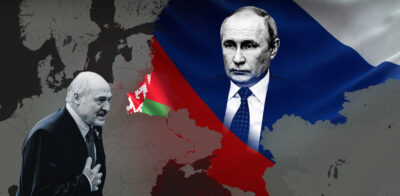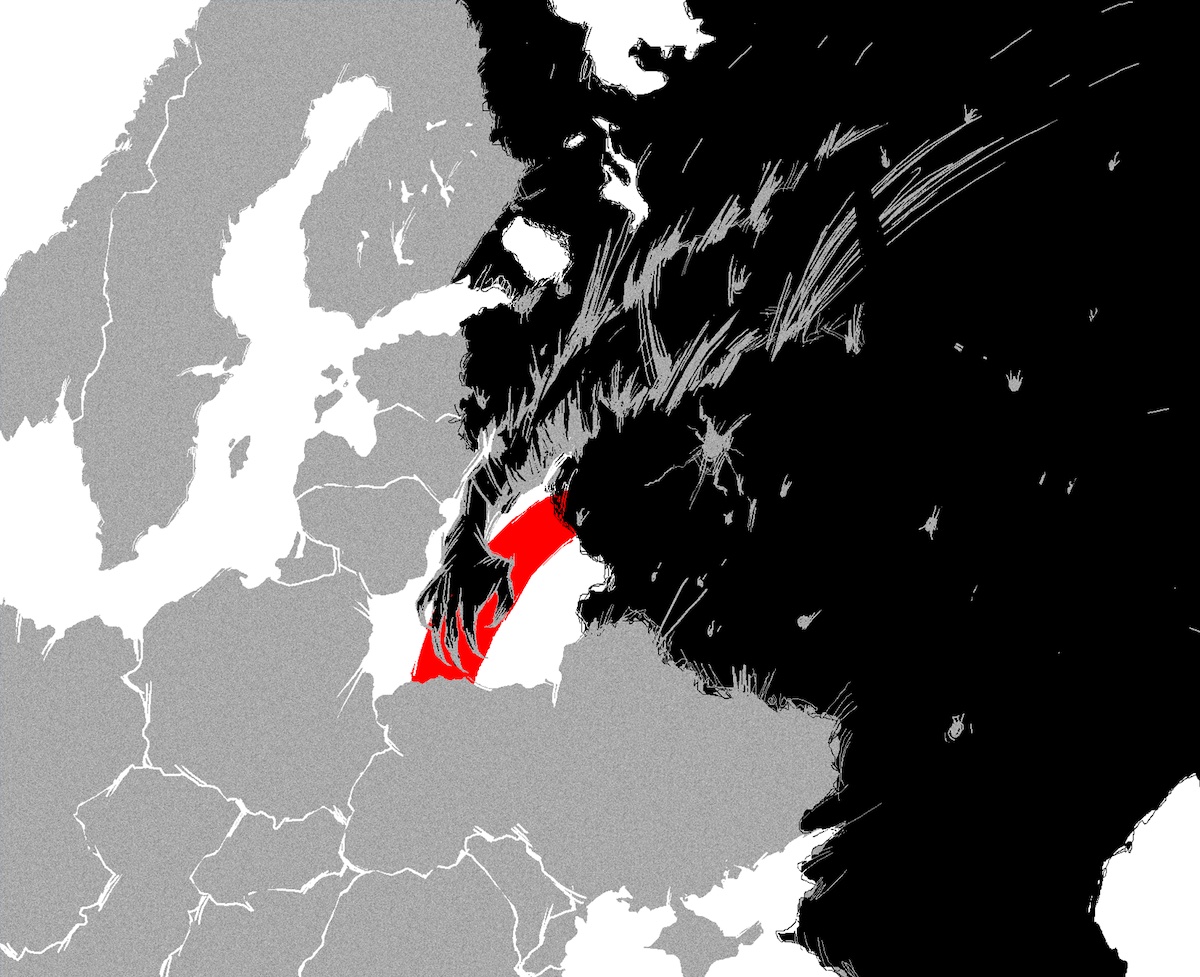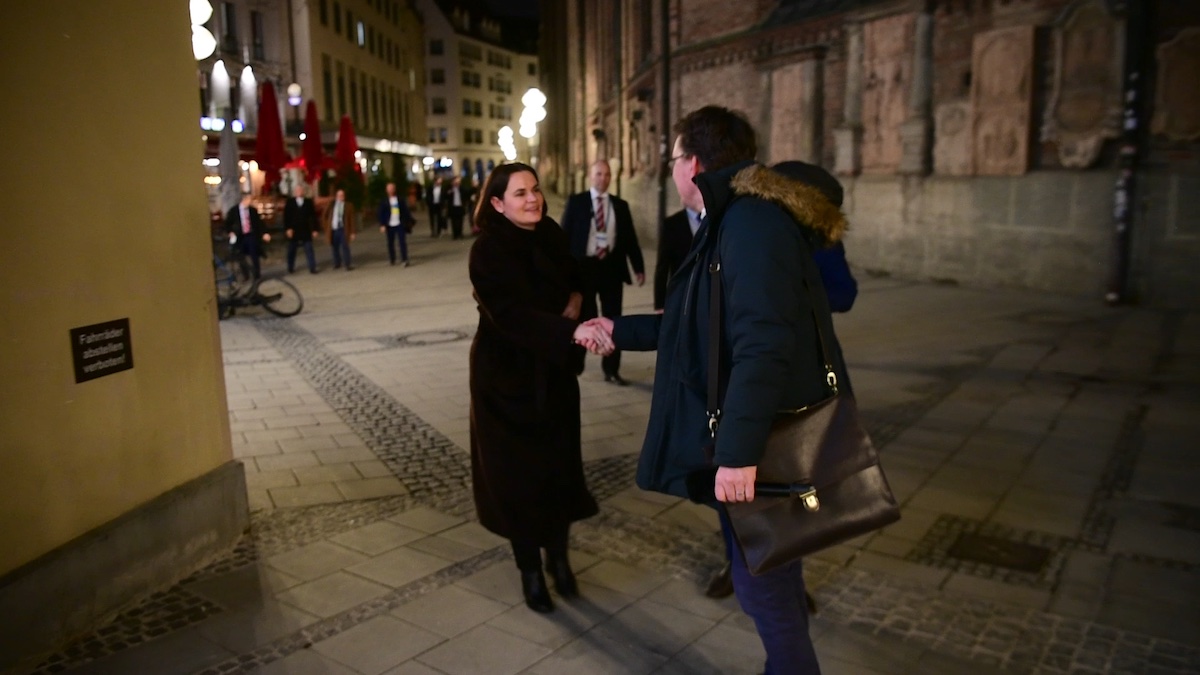Illustration: Karl-Erik Leik, Mart Nigola (Delfi Estonia) 2023-02-20
Illustration: Karl-Erik Leik, Mart Nigola (Delfi Estonia) 2023-02-20
We have obtained a document that shows how Russia plans to take control of Belarus. The strategy, written for Vladimir Putin’s administration, envisions the Russian incorporation of Belarus by 2030.
In the fall of 2021, while the Kremlin’s top leadership was busy preparing for the invasion of Ukraine, a presidential team was discussing another secret plan. The team was supervised by Dimitry Kozak, a man from Putin’s old St. Petersburg squad, formally the deputy head of the presidential administration. As with the invasion of Ukraine, this plan was designed to help achieve Putin’s ambition: the creation of Greater Russia.
A detailed roadmap, an action plan compiled by the Directorate for Cross-Border Cooperation, arrived on the now 64-year-old Kozak’s desk. Additional inputs to this action plan came from Russia’s intelligence agencies, the FSB, the SVR, and the GRU. The document, titled “Strategic goals of the Russian Federation in the Belarusian direction,” is basically a to-do list detailing how Russia wants to absorb Belarus by 2030.
The more than dozen-page internal document has never been published before. VSquare obtained it with an international group of journalists from Delfi Estonia, Dossier Center, Expressen, Frontstory, Kyiv Independent, Belarusian Investigative Center, Süddeutsche Zeitung, Westdeutscher Rundfunk WDR and Yahoo News. The document is a plan to take total control of Belarus over the course of this decade. It describes the Kremlin’s political, economic, and military strategy. Out of the Visegrád countries, Poland is mentioned five times in the document.
Besides these direct mentions of Poland, there would be other serious military and security consequences to both Poland and the other Visegrád region countries were Russia to take over Belarus. More than a thousand kilometers of new border section between NATO countries and Russia would emerge, likely with Russian military forces and missile systems stationed along the border with Latvia, Lithuania and Poland. The Polish-Lithuanian border area called the Suwalki Corridor could also come under pressure by incoming Russian forces.
But what does the Kremlin’s Belarus strategy sound like? First and foremost, it envisions ”ensuring the predominant influence of the Russian Federation in the socio-political, trade-economic, scientific-educational and cultural-information spheres of the Republic of Belarus.” Russian goals are divided into short-term (by 2022), medium-term (by 2025) and long-term (by 2030). As short-term goals, the document lists, among others
- Joint counteraction [with Belarus – ed.] to the expansion of NATO, the intensification of military preparations of the North Atlantic Alliance in the Republic of Poland and the Baltic countries;
- Formation of pro-Russian sentiments among the political and military elites, the population of Belarus;
- Limiting the influence of nationalist and pro-Western forces in Belarus;
- Completion of the constitutional reform in Belarus, taking into account the interests of the Russian Federation;
- Creation of political associations enjoying broad public support, advocating for the development of Russian-Belarusian integration;
- Reorientation to Russian ports of the entire volume of products transshipment through the ports of the Baltic countries and the Republic of Poland.
Information under control
The Russian document envisions the introduction of a single currency as well as full cultural, information and scientific unification, including the launch of branches of Russian universities in Belarus and the creation of science and culture centers (Rossotrudnichestvo). The plan is precise here, calling for the establishment of representative offices in Mogilev, Grodno and Vitebsk. By 2030, Russia wants to fully russify its neighbor, controlling the information space and ensuring the dominance of Russian over the Belarusian language. How to ensure the friendliness of Belarusian society? With propaganda, that is, “the promotion in the media space and society of attitudes about the advantages of cultural, economic and political integration with the Russian Federation as the only opportunity to preserve the sovereignty of Belarus against the background of the aggressive expansion of the United States, Europe and China.”
Source: Kyiv Independent
In the document, we find a table with an analysis of the threats to the realization of Russia’s interests. In the political sphere, for example, threats consist of “the strengthening of the position of pro-Western and nationalist politicians in the circle of the Belarusian president.”
What does the Kremlin consider to be other threats to its plans?
- Problems with the sale of electricity generated at the Belarusian nuclear power plant as a result of a coordinated campaign of European countries;
- Intensification of the activities of western NGOs in Belarus;
- A significant increase in citizens of Belarus who received the Polish Card, as well as those focused on living, studying and working in the EU;
- Restructuring of energy security, including the reorientation of Belarus to oil supplies through the ports of Poland and Ukraine;
- Strengthening the positions of media financed by western countries and China in the Belarusian information space.
According to a source from a European intelligence agency with knowledge of this document, in 2021, when the Putin administration’s Directorate of Cross-Border Cooperation was reorganized, similar plans were created for Ukraine, the Baltic States and Moldova. “Russia takes such strategies seriously and is making serious efforts to implement them. At the same time, it is aware that Belarus is trying to torpedo these processes. Some of that is visible in public, for example, stalling the political integration process. The Russian Federation continues its pressure [on Belarus] regardless,” the source added.
Special unit for Cross-Border Cooperation
The document on Belarus, according to the source from a European intelligence agency, was sent to Dmitry Kozak, deputy head of the Russian presidential administration, among others. The departments for interregional relations and cross-border cooperation are both overseen by him. The latter, by Putin’s decree, began dealing with the “European direction” in August 2021. Its tasks include informational and analytical support to the presidential administration and also participation in “the preparation of proposals relating to the improvement of activities for the implementation of projects and programs to assist international development in the economic, political and humanitarian spheres.” These are the exact areas listed in the Belarus takeover strategy.
Kozak has been involved in directing the Kremlin’s Belarus policy for some time. “Our negotiations were positive, and we agreed to (..) improve the mechanism of integration and strengthen this integration,” he told TASSR news agency after one round of Russia-Belarus negotiations in Sochi in February 2020. Earlier, Kozak issued an ultimatum to Belarus regarding a gas price discount, stating that “negotiations between Belarus and Russia on gas will begin when the issue of integration is solved.”
The presidential administration’s Directorate of Cross-border Cooperation is headed by Alexei Filatov, a senior Kremlin official who was directly involved in plans to take over the Donetsk and Luhansk regions. Filatov was put on the EU sanctions list in April 2022 as “a high-ranking Kremlin official responsible for the coordination of the Kremlin’s aggressive policy, including malign influence activities, towards Ukraine and the occupied regions of Donetsk and Luhansk.” (His superior, Kozak has been on the sanctions list since 2014.)
According to findings from the London-based Dossier Center, Vadim Smirnov and Sergey Malenko, who have been overseeing “integration projects” since September 2021, and senior advisor Vadim Polishuk all also work in the same directorate. Interestingly, in 2013, Lithuanian media exposed Smirnov as a “Russian spy” who was said to be operating under cover of a researcher and journalist. During regular trips to Lithuania, he interviewed politicians, journalists and analysts, and “friended” prominent public figures on Facebook. Smirnov later began working in Putin’s presidential administration.
In the summer of 2021, the unit overseen by Smirnov was tasked with preparing a strategy for Belarus. The document–according to a Western intelligence officer with knowledge of the Kremlin’s inner workings–circulated through various Putin administration units. Russian intelligence services and military officers were to provide their own input into the plan. At the time, the head of GRU military intelligence was Igor Olegovich Kostyukov. Andrei Vladimirovich Greshnikov was responsible for the Belarusian direction of the military intelligence. In turn, on the side of the SVR (Russian foreign intelligence service), the Belarusian direction was supervised by Vladimir Vladimirovich Krugliakov. Aleksandr Alexandrovich Strelnikov, who was responsible for the Belarusian direction and the Baltics, among others, was to participate in formulating the strategy from the FSB (internal security agency) side.
We asked sources in western and NATO intelligence services, as well as civilian experts, about the Russian document. (We are not publishing the whole document for security and source protection reasons.)
“The paper and its content are absolutely plausible and realistic,” assesses a senior intelligence officer of a NATO country. “In the summer of 2021, it was assumed that in six months at the latest, Ukraine would be defeated and a puppet government installed, and everything that the Kremlin planned for Belarus, according to the paper, would certainly have been implemented there.”
Michael Carpenter, US ambassador to the OSCE, has no doubt: “Russia’s goals with regards to Belarus are the same as with Ukraine, only in Belarus it relies on coercion rather than war. Its end goal is still wholesale incorporation.”
In contrast, according to Rainer Saks, former head of Estonia’s Foreign Intelligence Service, the long-term goals of Russia’s strategy appear to be key. “Of course, Russia will take control of Belarus, but the question is if it does so at the cost of independence. It is surprising to me why this target – 2030 – is set so far ahead. Why should Russia wait so long?” Saks wonders.
Belarusian political scientist Professor Valer Karbalevich takes a detached approach:
“There are always a lot of plans in the administrations of both Russia and Belarus, and not all of them are adopted for implementation. That is why I would be skeptical about it for the time being. Russia is so strongly tied up in the war in Ukraine that the long term plans for a decade ahead are likely to not be the center of Putin’s attention. The war in Ukraine has set a new dynamic for the whole region. The fates of Belarus, Russia, and Ukraine depend on its outcome.”
We also sent a media inquiry to the Putin administration with questions about the content of the document and their plans for Belarus. By the time of publication, we had not received a response.
Phone call to Putin
Svetlana Tikhanouska, leader of the Belarusian opposition, has no doubt that the currently existing Union State between Russia and Belarus is a threat to the Belarusian people and Belarusian statehood. “It is not a union of equals – it is a roadmap for the absorption of Belarus by Russia. The Union State is a screen for Russia to establish control over Belarus. Russia is conducting the hybrid occupation of Belarus: in political, economic, military and information space. It seems that Lukashenka doesn’t decide on anything anymore, except repressions.”
How to stop Russia’s further takeover of Belarus? “To weaken Russia, empower Belarusians and Ukrainians. The West must clearly demand Russian troops be withdrawn from Belarus. Sometimes I hear voices: let’s leave Belarus for later. It’s a mistake. The fates of Belarus and Ukraine are intertwined, and the problems must be solved comprehensively,” believes Tikhanouska.
Back in 2020, Aleksandr Lukashenko tried to play two pianos, maintaining both closeness to Russia and a certain openness to the West. Everything changed with the rigged elections in 2020 and the violent suppression of demonstrations.
“We still recognize Belarus as a sovereign state, although there is little of that independence left. This is the aftermath of Alexander Lukashenko’s mistakes in 2020: rigged elections and a phone call to Putin asking for support. The bill that has come to pay for this is accelerated economic and military integration,” calculates Anna Maria Dyner of the Polish Institute of International Affairs (PISM).
Dyner has no doubt that Russia’s strategic goal with regard to Belarus is to maintain control over it – primarily militarily, but also politically and economically.“Maintaining a permanent Russian military presence in Belarus basically guarantees the realization of the other strategic goals, i.e., taking political and economic control of the country. This situation guarantees Russia an increased sense of security, that is, some cover from NATO countries, while flanking the military operation in Ukraine,” the expert says.
Piotr Zochowski of the Polish Center for Eastern Studies (OSW): “Russia’s incorporation of Belarus, which was much talked about before the war with Ukraine, is not in the Kremlin’s interest today [according to] common sense. Annexing Belarus could bring Russia further trouble. For now, the situation in Belarus, from the Kremlin’s point of view, is stable. Repression is so effective that the population has nothing to say.”
Experts agree that the war in Ukraine has reduced the remnants of Lukashenko’s sovereignty. “He has given Russia everything he can. In December, an agreement correcting the 1997 agreement was signed at the inter-ministerial level, and the Russians got the freedom to use Belarusian territory for military purposes without the formal approval of the Belarusian authorities,” Zochowski points out, adding that Lukashenko has met with Putin 14 times in the past year. Each time he stressed that Belarus and Russia are allies.
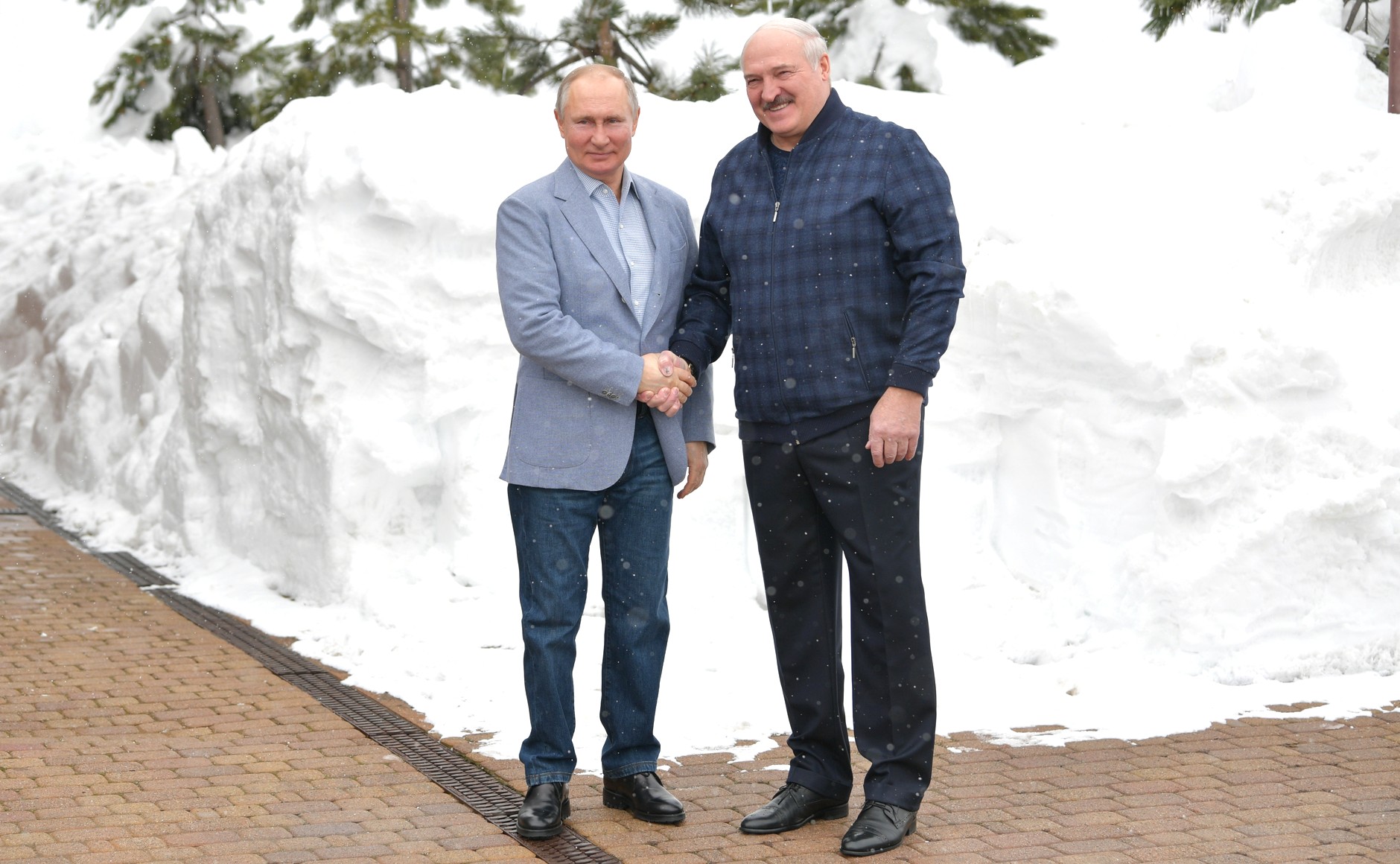
Meeting of Vladimir_Putin and Alexander Lukashenko, 22.02.2021. Source: kremlin.ru / Wikimedia Commons, CC 4.0
The last time they met was last Friday near Moscow. According to the Nasha Niva portal, when Putin thanked Lukashenko for coming, the Belarusian dictator was said to have responded with a joke: “As if I could disagree.”
Before he boarded the plane, Lukashenko attacked Poland during a press conference. He called it the “hyena of Europe.” The Belarusian politician reacted this way to the closure of the Bobrowniki border crossing – the Polish Interior Ministry closed the border crossing after Belarus announced a draconian sentence of 8 years in a penal colony for Polish journalist Andrzej Poczobut.
New old union
A Russian-Belarusian Union State existed in the 1990s. As Anton Bendarjevskiy, a Belarusian foreign policy expert living in Hungary, pointed out, it was a remnant of Belarus’ ambitions when a weakened Russia was in crisis and Lukashenko, who had been in power since 1994, was trying to squeeze as much as he could out of Russia. “After coming to power, Putin dashed Lukashenko’s hopes. The union treaty sat on the shelf for almost two decades, only after the annexation of Crimea was dusted off and Moscow began demanding its implementation. Until the 2020 elections, Lukashenko played for time”.
It was a year after the 2020 events that the Directorate of Cross-border Cooperation prepared the plan for the takeover of Belarus.
Bendarjevskiy says that Russia is currently running two forced integration projects in parallel: one is a military attempt to take over Ukraine, and the other is a forced political integration with Belarus.
While Lukashenko keeps repeating that Belarusians can join the fight only “in case of aggression against Belarus,” no one doubts that Belarus is a co-aggressor even without its troops on Ukrainian soil.
“At present, Belarus is a giant backstop for Russian forces, which lately have been mainly engaged in training the newly mobilized on Belarusian training grounds. It has made available its reserves of ammunition and military equipment, which have been sent to the Donbass region,” Piotr Zochowsky of OSW said.
In his view, the apparent reluctance on the question of the entry of Belarusian troops into Ukraine indicates that the regime in Minsk considers such a scenario unfavorable, likely to cause public discontent over participation in a war it does not understand.
András Rácz, a Budapest-based senior research fellow with the German Council on Foreign Relations (DGAP) concludes: “Belarus is a full participant in the war. It allows Russian forces to use Belarusian territory, airspace, military infrastructure, railroad infrastructure, hospitals, warehouses. It also supplies Russia with military equipment and combat vehicles, and has currently handed over more than a hundred tanks to the Russian army. Lukashenko also recently boasted that three Belarusian factories are already producing Su-25s, and many of the missiles and drones aimed at Kyiv and northern Ukraine have been launched from Belarusian territory. Even if the Belarusian army itself is not attacking Ukraine, it is still an integral part of this war.”
However, if Russia were to take over Belarus, it would still make a huge difference to the current state of war, and the security outlook of Central Eastern Europe’s NATO member countries would severely deteriorate. “If Belarus becomes part of the Russian Federation, there will be an extra 1250 km NATO-Russia border. From then on, there will be no question of Russian military forces being permanently stationed on the territory of Belarus,” Rácz says. “The question from the Visegrad Group side is whether combat capable Russian troops will be permanently stationed in Belarus. Because they already have Russian military objects, but no Russian military bases yet.” This would mean a real difference, because, for example, “if a strong Russian air defense force is permanently deployed in Belarus, it will also change the defense calculus for Poland as the Russian-Belarusian force can intercept missiles from Poland from Belarusian territory,” Rácz adds.
“A further result of the unification of the two countries would be to increase Russia’s so-called strategic depth by hundreds of kilometers to the West, which would strengthen the Russian leadership’s confidence in taking up a possible confrontation with the West,” says Péter Buda, a former senior Hungarian counterintelligence officer. He agrees that the immediate risk of the unification is primarily a military risk, explaining that the Belarusian army is already working very closely with the Russian Western Military District.
“The Polish capital would be some 200 km away from Russian weapons,” Buda says, adding that the real danger is that the Suwalki Corridor – the Polish-Lithuanian border area cutting off Belarus from Russia’s Kaliningrad exclave territory – could come under direct pressure. “Obviously, it is questionable whether Russia would dare to undertake a military invasion of the Suwalki Corridor in view of possible Western reactions. But in any case its military potential would be available for this, and this fact alone – even without any concrete military action – would mean an increase in Russia’s power projection capability.”
The text was written as part of an international collaboration with:
Holger Roonemaa, Delfi Estonia
Mattias Carlsson, Expressen (Sweden)
Stas Ivashkevich, Belarusian Investigative Center
Anna Myroniuk, Kyiv Independent
Michael Weiss, Yahoo News
Jörg Schmitt, Süddeutsche Zeitung
Anna Gielewska is co-founder and editor-in-chief of VSquare and co-founder of Polish investigative outlet FRONTSTORY.PL. She is also vice-chairwoman of Fundacja Reporterów (Reporters Foundation). A journalist specializing in investigating organized disinformation and propaganda, Gielewska was the John S. Knight Fellow at Stanford University (2019/20) and has been shortlisted for the Grand Press Award (2015, 2021, 2022) and the Daphne Caruana Galizia Award (2021, 2023). She was the recipient of the Novinarska Cena in 2022.
VSquare’s Budapest-based lead investigative editor in charge of Central European investigations, Szabolcs Panyi is also a Hungarian investigative journalist at Direkt36. He covers national security, foreign policy, and Russian and Chinese influence. He was a European Press Prize finalist in 2018 and 2021.

